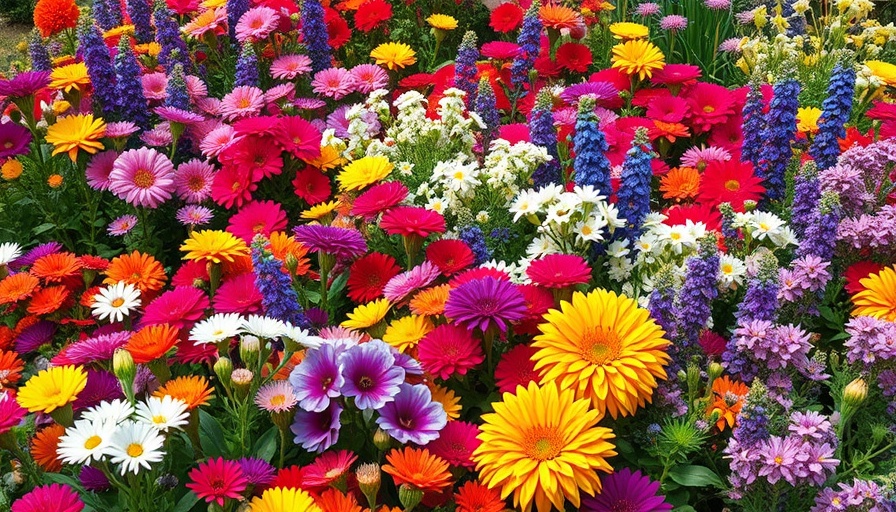
Creating Your Dream Perennial Garden: A Comprehensive Guide
Are you yearning for a garden that provides vibrant blooms, delightful scents, and the charm of changing seasons with minimal upkeep? Designing a perennial garden can transform your dream into reality, allowing you to enjoy beautiful plants year after year without the hassle of replanting each season. Perennials, which are plants that come back consistently, are perfect for homeowners aiming for a sustainable and colorful landscape.
Planning: The First Step Towards Your Perennial Sanctuary
Before you dig in, the significance of planning cannot be overstated. Utilizing a garden journal can help sketch your ideas and familiarize yourself with the planting area. Note essential factors such as sunlight exposure, soil conditions, and existing landscape features. By carefully jotting down your thoughts and research, you'll be on your way to creating a beautifully crafted space that harmonizes with the environment. Moreover, accurate soil testing, either through local extension services or DIY kits, provides valuable insights into pH levels and nutrient contents, allowing for appropriate amendments tailored to your plants’ needs.
The Importance of Growing Zones and Local Climate
Understanding your local hardiness zone is vital when selecting the right perennials. As gardening enthusiasts across the globe know, not all plants thrive in every climate. Factors such as temperature, humidity, and seasonal length play pivotal roles in ensuring successful growth. For example, certain perennials flourish in moist, temperate soils, while others prefer drier conditions. Choosing plants that are well-suited to your environment fosters a more resilient and vibrant garden.
Designing with Purpose: Hardscape Elements
Incorporating hardscape elements into your garden design adds depth and structure. Walkways, patios, and decorative stones not only enhance the aesthetic but also serve functional purposes by directing foot traffic and managing soil erosion. Consider incorporating natural stones, wooden elements, or even recycled materials to create pathways that complement your garden’s organic beauty.
A Selection of Plants That Thrive
Vegetable gardening enthusiasts can benefit from incorporating perennial varieties that also bear fruits and vegetables, integrating your food-growing goals into your design. Consider pest-resistant plants that not only beautify your garden but also deter unwanted insects naturally. Select a mix of herbs, flowers, and edible plants to create a diverse ecosystem that invites beneficial pollinators.
The Importance of Watering and Irrigation
Effective irrigation is critical to the success of your perennial garden. Understanding your plants’ water needs and developing a suitable irrigation plan is essential. Xeriscaping, or designing to reduce water use, is a sustainable method that encourages the planting of drought-resistant perennials. Consider ways to collect rainwater or utilize efficient drip irrigation systems to minimize waste and optimize moisture retention.
Fostering a Sustainable Future in Your Backyard
The joy of gardening extends beyond aesthetics; it contributes to healthier living and environmental sustainability. By implementing climate-friendly gardening practices, such as composting organic matter and nurturing rich soil, you can create a self-sustaining ecosystem. Teach children the values of growing their food and enjoying the benefits of nature. Involve your community in garden sharing projects to promote connection and foster harmony in shared outdoor spaces.
Monitoring Growth and Regular Maintenance
Once planted, the maintenance of your perennial garden is minimal, but it cannot be overlooked. Regular inspections for pests, watering, and mulching help ensure your garden remains healthy and vibrant. As seasons change, consider rotating plants for optimal growth and resilience. Joining local gardening clubs or participating in forums can provide ongoing support and tips tailored to your specific climate and soil conditions.
Conclusion: Start Your Gardening Journey Today
With some thoughtful planning and a sense of adventure, you'll be ready to start designing your perennial garden. Enjoy the process, celebrate the learning moments, and reap the rich rewards of a blooming sanctuary right in your own backyard. Embrace the opportunity to cultivate your garden while contributing to environmental sustainability and community well-being.
 Add Row
Add Row  Add
Add 




 Add Row
Add Row  Add
Add 

Write A Comment